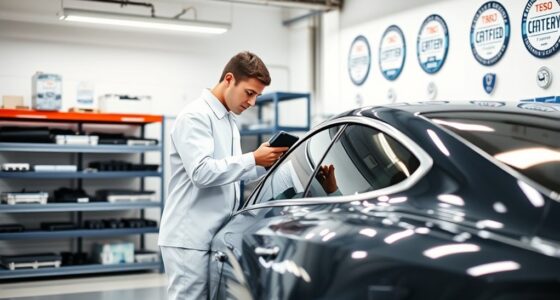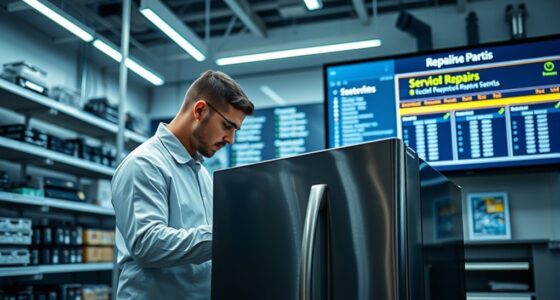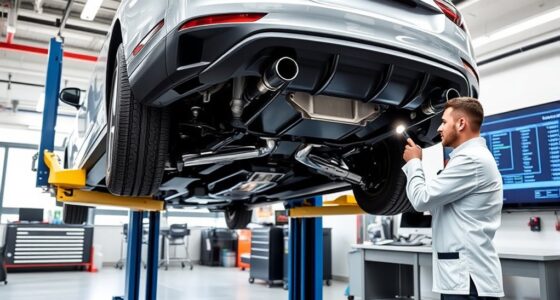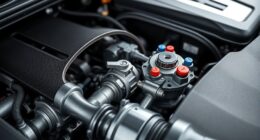To keep your hybrid vehicle running smoothly, schedule regular inspections every 5,000 to 10,000 miles or annually. These check-ups assess the battery’s health, cooling system, and other essential components, helping prevent costly repairs and ensuring peak performance. Keep an eye out for symptoms like reduced efficiency or warning lights, and follow your manufacturer’s recommended maintenance schedule. Staying proactive now will help you maximize your hybrid’s lifespan—there’s more to learn on how to do this effectively.
Key Takeaways
- Hybrid batteries generally require inspections every 5,000 to 10,000 miles or annually.
- Regular check-ups evaluate battery health, cooling system function, and signs of degradation.
- Proper maintenance, including fluid changes and software updates, supports optimal hybrid system performance.
- Extreme temperatures and driving habits influence service needs and battery longevity.
- Early detection of issues through scheduled inspections helps prevent costly repairs and prolongs vehicle life.

Hybrid vehicles often require different maintenance schedules than traditional gas-powered cars, but understanding their service intervals is key to keeping them running smoothly. One of the most critical components in a hybrid is the battery, which plays a central role in your vehicle’s performance and efficiency. Knowing about battery longevity and how it influences your maintenance schedule can help you avoid unexpected breakdowns and extend the life of your hybrid. Typically, hybrid batteries are designed to last between 8 to 15 years or around 100,000 to 150,000 miles, but this can vary depending on driving habits, climate, and maintenance practices. Regular check-ups and proper care are essential to maximize their lifespan.
Your vehicle’s manufacturer provides specific intervals for inspecting and maintaining the hybrid battery. Usually, these checks are recommended every 5,000 to 10,000 miles or annually. During these inspections, technicians assess the battery’s state of health, look for signs of degradation, and ensure the cooling system is functioning properly. Maintaining a good cooling system is crucial because excessive heat can accelerate battery wear. If you notice symptoms like reduced fuel efficiency, sluggish acceleration, or warning lights related to the hybrid system, it’s a sign that your maintenance schedule may need adjusting. Addressing issues early can help preserve battery health and prevent costly repairs later.
In addition to battery checks, your maintenance schedule should include regular fluid changes, brake inspections, and software updates, all of which support the longevity of the hybrid system. Hybrid batteries are less prone to the wear and tear that traditional car batteries face, but they still require attention. Following the manufacturer’s recommended service intervals ensures that the battery remains in prime condition. Keep in mind that extreme temperatures—hot or cold—can impact battery longevity, so parking in shaded or sheltered areas can help extend its life.
Ultimately, staying on top of your hybrid’s maintenance schedule isn’t just about following a timetable; it’s about understanding how each component, especially the battery, contributes to the vehicle’s overall health. Regular inspections and proactive care will help you get the most out of your hybrid, ensuring it runs efficiently for years to come. By paying attention to battery longevity and adhering to recommended service intervals, you keep your vehicle performing at its best and avoid costly repairs down the line.
Frequently Asked Questions
How Do Hybrid Service Intervals Differ From Traditional Vehicles?
You’ll find that hybrid service intervals differ from traditional vehicles mainly because of the battery lifespan and regenerative braking system. Hybrids often require less frequent oil changes but need regular checks on the battery and regenerative braking components. These systems help extend the battery’s life and improve efficiency. By maintaining these parts, you guarantee your hybrid runs smoothly, reducing overall maintenance costs and keeping it in ideal condition longer.
Are There Specific Signs Indicating Hybrid Service Is Needed Sooner?
Did you know hybrid batteries can last over 8-10 years? You should get service sooner if you notice a drop in battery health or an engine warning light. These signs indicate your hybrid needs attention before major issues develop. Staying alert to such indicators helps maintain performance and avoid costly repairs, ensuring your vehicle stays reliable and efficient longer. Regular checks can catch problems early, saving you time and money.
Can I Extend My Hybrid’s Service Intervals Safely?
You can’t safely extend your hybrid’s service intervals, as doing so risks battery lifespan and overall vehicle health. Regular maintenance ensures software updates keep your system running efficiently, preventing issues before they arise. Follow your manufacturer’s recommended schedule, and consult your dealer if you notice any signs of trouble. Proper care maintains your hybrid’s performance and longevity, saving you money and avoiding costly repairs down the line.
What Are the Consequences of Delaying Hybrid Maintenance?
Delaying hybrid maintenance can lead to battery degradation and system failures. When you skip scheduled service, the battery’s health worsens, reducing its lifespan and efficiency. This also risks causing other system failures, like brake or cooling issues, which can be costly to repair. Regular maintenance helps catch problems early, ensuring your hybrid runs smoothly and efficiently, saving you money and preventing unexpected breakdowns down the line.
Do Hybrid Service Intervals Vary Between Different Brands?
Yes, hybrid service intervals do vary between different brands. You should follow brand specific maintenance schedules and manufacturer guidelines to guarantee your hybrid runs smoothly. Some brands recommend more frequent check-ups for the battery or electric motor, while others have longer intervals. Always consult your vehicle’s manual or dealer to get accurate, brand-specific service intervals, as adhering to these helps maintain performance and avoid costly repairs.
Conclusion
So, next time you’re thinking about ignoring those service intervals, remember—hybrid vehicles might be eco-friendly, but they still need a little TLC. Skipping maintenance might save you a buck now, but it could cost you a lot more later. Ironically, neglecting those schedules could turn your green dream into a costly nightmare. So, stick to the recommended intervals—you’ll thank yourself when your hybrid keeps humming along smoothly. After all, even eco-friendly cars deserve a little love.









